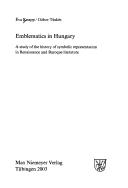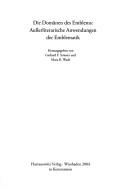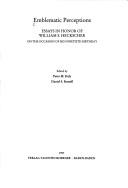| Listing 1 - 10 of 23 | << page >> |
Sort by
|
Book
ISBN: 9781443851848 1443851841 9781443851862 1443851868 Year: 2017 Publisher: Newcastle upon Tyne Cambridge Scholars Publishing
Abstract | Keywords | Export | Availability | Bookmark
 Loading...
Loading...Choose an application
- Reference Manager
- EndNote
- RefWorks (Direct export to RefWorks)
"The art of the emblem is a pan-European phenomenon which developed in Western and Central Europe in the early modern period. It adopted meanings and motifs from Antiquity and the Middle Ages as part of a general humanistic impulse. Technological developments in printing that permitted the combination of letterpress with woodblock, and later copperplate, images, ensured that the emblem spread rapidly by way of printed collections. With time, emblematic ideas moved beyond Europe, conveying their insights and wisdom in the compact form of the book. These same books came to influence artists and designers working in the decoration of buildings, furniture, and household items, so that emblems entered personal life; they infiltrated festive culture, too. In such environments beyond the book, emblems were transported, adapted, and embedded in new functional contexts shaped by social, political, or religious conditions, but also by architectonical and regional art historical parameters. The results of these transformations are often of an intricate and complex meaning. The combination of word and image that constitutes the emblem still has resonance in contemporary art and architecture. The study of emblems allows us to look back at the collaborative endeavours of creative minds of earlier times from across Europe and beyond. At a time when that continent is under strain, and the world in general seeks to come to terms with globalization, emblems allow reflection on strongly shared cultural values and connections."
Emblems --- Emblems in literature --- History
Book
ISBN: 9788865506585 Year: 2018 Publisher: Lucca : Maria Pacini Fazzi editore,
Abstract | Keywords | Export | Availability | Bookmark
 Loading...
Loading...Choose an application
- Reference Manager
- EndNote
- RefWorks (Direct export to RefWorks)
Emblems in literature. --- Italian literature --- History and criticism

ISBN: 3484365862 3110950820 9783110950823 9783484365865 Year: 2003 Publisher: Tübingen : Niemeyer,
Abstract | Keywords | Export | Availability | Bookmark
 Loading...
Loading...Choose an application
- Reference Manager
- EndNote
- RefWorks (Direct export to RefWorks)
The main aim of the work is to present emblematics in Hungary in its European context, and to show the reciprocal influence between that phenomenon and mainstream literature. The description of the theoretical and historical development in Hungary is supplemented by a series of case studies examining the effect of emblematics upon various literary genres. The final chapter analyzes the link between literary emblematics and the visual arts by looking at a specific example. As in most European countries, emblematics in Hungary is part of a complex labyrinth of literary modes of thought and expression. A relative poverty of theoretical writing went hand in hand with a considerable range of emblematic practice. The emblem proved to be a transitional form between the period when signs and motifs were regarded as having specific and fixed meanings and the modern period when we have developed a different and shifting concept of language and meaning. At the same time as emblems began to penetrate the more popular levels of national culture and literature, they also became more specialized. Hungarian emblematics used, for the most part, existing pictorial and textual combinations of pictures and texts. They employed the emblem notably in genres and texts of the genus demonstrativum, which referred to matters which were topical at the time.
Baroque literature --- Emblems in literature. --- European literature --- Hungarian literature --- History and criticism. --- History and criticism --- Magyar literature --- Balkan literature --- Emblems in literature
Book
ISBN: 9781180134266 1180134265 9780889843585 0889843589 Year: 2013 Publisher: Erin, Ont. : Porcupine's Quill,
Abstract | Keywords | Export | Availability | Bookmark
 Loading...
Loading...Choose an application
- Reference Manager
- EndNote
- RefWorks (Direct export to RefWorks)
Draws on the author's own considerable wit and knowledge to help readers understand the myth, mystery and meaning behind ten literary emblems, published in 1972. In this book, the author conducts an exhaustive investigation of the 'magnetic arrangement' that links each emblem with some of Reaney's best-known fiction, poetry, drama and painting.
Emblems in literature. --- Reaney, James, --- Criticism and interpretation. --- Reaney, James Crerar
Dissertation
Abstract | Keywords | Export | Availability | Bookmark
 Loading...
Loading...Choose an application
- Reference Manager
- EndNote
- RefWorks (Direct export to RefWorks)
Emblem books, Latin --- Emblems in literature. --- Humanists --- History. --- Zsámboki, János, --- Hungary --- Intellectual life
Book
Year: 1870 Publisher: London : Trübner & co.,
Abstract | Keywords | Export | Availability | Bookmark
 Loading...
Loading...Choose an application
- Reference Manager
- EndNote
- RefWorks (Direct export to RefWorks)
Emblem books, English --- Emblems --- Emblems in literature. --- History. --- Shakespeare, William, --- Sources.
Book
ISBN: 9173463426 9789173463423 Year: 1999 Volume: 74 Publisher: Göteborg: Acta Universitatis Gothoburgensis,
Abstract | Keywords | Export | Availability | Bookmark
 Loading...
Loading...Choose an application
- Reference Manager
- EndNote
- RefWorks (Direct export to RefWorks)
Emblemen in de literatuur --- Emblems in literature --- Emblèmes dans la littérature --- Brontë, Charlotte --- Brontë, Emily --- Christianity and literature --- England --- History --- Emblems
Book
ISBN: 9789004407633 9004407634 9004407642 9789004407640 Year: 2020 Publisher: Leiden Boston Brill | Rodopi
Abstract | Keywords | Export | Availability | Bookmark
 Loading...
Loading...Choose an application
- Reference Manager
- EndNote
- RefWorks (Direct export to RefWorks)
In this book, Heather McAlpine argues that emblematic strategies play a more central role in Pre-Raphaelite poetics than has been acknowledged, and that reading Pre-Raphaelite works with an awareness of these strategies permits a new understanding of the movement’s engagements with ontology, religion, representation, and politics. The emblem is a discursive practice that promises to stabilize language in the face of doubt, making it especially interesting as a site of conflicting responses to Victorian crises of representation. Through analyses of works by the Pre-Raphaelite Brotherhood, Christina Rossetti, Dante Gabriel Rossetti, Gerard Manley Hopkins, A.C. Swinburne, and William Morris, Emblematic Strategies examines the Pre-Raphaelite movement’s common goal of conveying “truth” while highlighting differences in its adherents’ approaches to that task.
English poetry --- Emblems in literature --- Pre-Raphaelitism --- Preraphaelitism --- Art --- English literature --- History and criticism&delete& --- Theory, etc --- History and criticism --- Theory, etc.

ISBN: 3447050667 9783447050661 Year: 2004 Volume: 39 Publisher: Wiesbaden: Harrassowitz,
Abstract | Keywords | Export | Availability | Bookmark
 Loading...
Loading...Choose an application
- Reference Manager
- EndNote
- RefWorks (Direct export to RefWorks)
German literature --- Graphic arts --- emblems [allegorical pictures] --- Thematology --- anno 1600-1699 --- anno 1500-1599 --- Emblems --- Emblems in art --- Emblems in literature --- Heraldry --- Signs and symbols --- Symbolism --- Emblem books --- Congresses --- Emblems - Congresses --- Emblems in art - Congresses --- Emblems in literature - Congresses --- Duitse school

ISBN: 3873204363 Year: 1997 Volume: 36
Abstract | Keywords | Export | Availability | Bookmark
 Loading...
Loading...Choose an application
- Reference Manager
- EndNote
- RefWorks (Direct export to RefWorks)
Arts --- Kunsten --- Emblems --- -Emblems in literature --- 82-84 --- 094:82-84 --- Heraldry --- Signs and symbols --- Symbolism --- History --- Spreuken. Citaten --- Oude en merkwaardige drukken. Kostbare en zeldzame boeken. Preciosa en rariora-:-Emblemen. Spreuken. Citaten --- Heckscher, William S. --- Emblems in literature. --- History. --- 094:82-84 Oude en merkwaardige drukken. Kostbare en zeldzame boeken. Preciosa en rariora-:-Emblemen. Spreuken. Citaten --- 82-84 Spreuken. Citaten --- Emblems in literature --- Heckscher, William Sebastian --- 82-84 Maxims. Gnomic utterances. Sententiae. Aphorisms. Pithy sayings. Adages. Proverbs. Thoughts. Table-talk. Obiter dicta --- Maxims. Gnomic utterances. Sententiae. Aphorisms. Pithy sayings. Adages. Proverbs. Thoughts. Table-talk. Obiter dicta --- 82-84 Emblemen. Spreuken. Citaten --- Emblemen. Spreuken. Citaten
| Listing 1 - 10 of 23 | << page >> |
Sort by
|

 Search
Search Feedback
Feedback About UniCat
About UniCat  Help
Help News
News